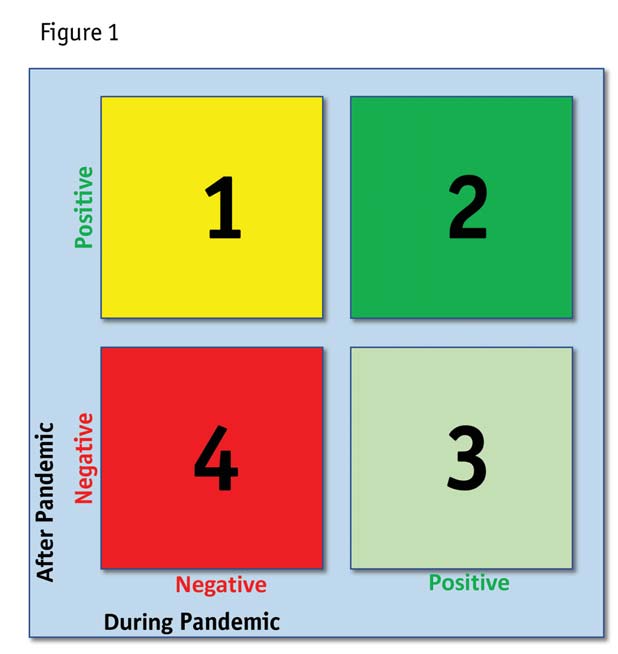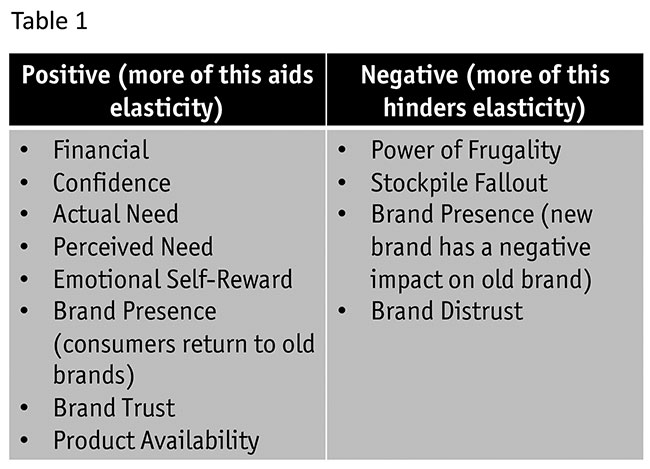Habits old and new
Editor's note: Lincoln Merrihew is a Boston-based independent consultant.
 There’s good news and bad news. The good news is that we get to dive deeper into consumer elasticity (a concept I first floated over a decade ago). The bad news is that it’s relevant again because of the current economic turmoil brought on by COVID-19.
There’s good news and bad news. The good news is that we get to dive deeper into consumer elasticity (a concept I first floated over a decade ago). The bad news is that it’s relevant again because of the current economic turmoil brought on by COVID-19.
Let’s start with defining what the terms mean. “Consumer” refers to people buying goods and services. Keep in mind that consumers purchase for many different reasons, not all of them logical. “Elasticity” refers to the ability of something to resume its normal shape after being stretched or compressed.
Certainly in the current climate, consumers – and businesses – are feeling both stretched and compressed. Consumer elasticity as a concept, therefore, refers to the extent to which consumers will return to normal behaviors as the economy recovers. It is more complex than the traditional price elasticity, which is rather sterile.
Consumer elasticity impacts all businesses. Those that have been hit adversely want their old shoppers back, while those that have benefited (e.g., sellers of toilet paper and disinfectants) want to keep their new customers and new sales levels.

To frame the discussion, it’s useful to think of businesses in two ways: those that have benefited from the current crisis – whether by design or happenstance – and those that have not. That’s shown in Figure 1 using the X-axis. The Y-axis represents how those two categories will fare in the post-COVID-19 era. Box 2 represents the ideal: a brand or product that experiences a positive impact during the crisis and maintains it afterwards. They want very low consumer elasticity because they don’t want a return to the old normal.
An example of a Box 2 company could be a maker of hand sanitizer. People bought more as the pandemic unfolded and, as a preventative measure, may continue to buy it afterwards to feel safe and prepared. And they may have it everywhere: many rooms in the house, their cars, their offices, etc. So, a maker of hand sanitizer could experience a boost during the crisis and maintain boost levels afterwards.
An example of Box 1 would be your favorite restaurant. It may have suffered during the pandemic, getting by on to-go orders, but as we come out the other side its customers return (i.e., they see complete consumer elasticity as customers return to pre-crisis behaviors).
Box 3 represents an unsustainable short-term gain. Some food-delivery services may fall into this category, with more people returning to dining out more often instead of having food delivered.
Components of consumer elasticity
Let’s think about what would make a consumer resume normal patterns vs. prevent them from doing so. Some of the components of consumer elasticity are explored below. While each element has its own elasticity, to help create a unifying equation around that, Table 1 groups them into positives and negatives. (In the table, brand presence in terms of negatives and positives refers to the pre-pandemic brand.)

Financial. This is the simplest one and one most people may focus on because it’s well-understood and relatively easy to measure. It refers to people’s ability to buy goods and services because they have the money to do so or can get credit at reasonable rates. The elasticity of this measure refers to how quickly financial wherewithal returns to pre-crisis levels, such as when furloughed consumers go back to work.
Confidence. Rather than consumer confidence in aggregate, this refers to how confident a given consumer is that the economy and their slice of it has recovered and – as importantly – will stay recovered. The elasticity of confidence refers to the extent to which consumers have been shell-shocked and the time it takes to recover.
Actual and perceived need. In some cases, consumers can postpone purchases and in some cases they cannot. You may be able to get by with a slow cellphone for another month but if it’s been damaged beyond use you’ll need to replace it now. Likewise, you can patch your jeans but you probably can’t patch your leaky car tire. Perceived need also has to do with what consumers feel is necessary. Some people may never return to dining out as much if they’ve become new fans of home cooking. Elasticity here refers to the extent to which consumers feel the need is now to replace or restart postponed purchases.
Stockpile fallout. This refers to the backlash of hoarding goods. If you have a garage full of toilet paper because you stockpiled, you’ll likely decide that you don’t need to buy more for several months once you feel things are somewhat back to normal. For these goods, the elasticity will be bumpy: extra purchases during the crisis followed by a pause, potentially followed by a return to normal. Of course, “normal” may have changed as consumers may feel that an extra-large supply of something all the time is prudent.
Emotional self-reward. This refers to the degree to which consumers treat themselves to a reward for a hard day’s work or simply for making it through the pandemic emotionally, physically and financially. The parallel is the classic Friday night beer after a hard work week or something akin to the L’Oreal hair color slogan “Because you’re worth it.” Elasticity here will be a function of when consumers feel that they have permission to celebrate. What constitutes a celebration is unknown. At this point, even eating out a restaurant could make some people giddy.
Power of frugality. In some past recessions, it became trendy to be frugal (almost the antithesis of the permission to celebrate). Meaning, not only was there a need to be frugal for financial reasons but it also became something akin to shabby chic. One example cited is the emergence of the tiny-house movement after the last recession, which was a pendulum swing away from the mega-mansions that seemed to be popping up everywhere. Elasticity here refers to the extent to which being minimalist becomes trendy and remains so.
Brand presence. Brand presence is one of the more complex components of consumer elasticity. (“Presence” is different from “familiarity.” Familiarity refers to the extent to which a consumer has heard of a brand. Presence refers to the biases created from having a brand visible and in your day-to-day life.) Complex because it addresses former brands and newly found brands and, in particular instances, when one brand has replaced another. In terms of former brands, elasticity pertains to consumers returning to old habits and brands. Some of those brands may have been abandoned after their products were simply not available and a consumer determined that the brand is no longer needed or desired. Elasticity here is also impacted by the extent to which a consumer has adopted a replacement brand and decides to stick with it even after the economy recovers. That could be because the new brand performs better or simply because the new brand is now the “habit” brand (i.e., the one the consumer has become accustomed to and is present in the household).
Brand trust. This is another complex brand-related component of consumer elasticity. It is less about availability and more about brand perceptions. For example, if the price of a product suddenly increased during the COVID-19 era, consumers may feel angry toward that brand – whether or not the price-gouging was the brand’s fault – which of course creates distrust. Likewise, availability: If the consumer feels a brand deliberately held back production to drive up prices, that negative connotation could contaminate consumers’ perceptions. In contrast, a brand that appears to have gone above and beyond during the crisis may earn a newfound trust. For example, automakers switching to production of ventilators and masks or companies buying up food that might otherwise be thrown away to give to people in need. We have already seen brands becoming more empathetic in messaging to create trust, along the lines of “we’ll get through this together.” The elasticity component refers to how long the impact of empathy is relevant and whether it returns to pre-pandemic levels.
Product availability and alternatives. Early in the COVID-19 era, some categories of items were simply not available. Consumers either went without or changed to products in different categories. For example, with salons and barbershops largely closed, some people cut and colored their own hair (or had friends do it). And with many restaurants closed, some consumers may have realized a newfound joy in cooking. Elasticity here refers to the extent to which consumers return to categories of products and services they used to buy vs. deciding they no longer need them or sticking with the new alternatives they discovered.
No easy feat
Measuring consumer elasticity is no easy feat. Each of the elements noted above has its own elasticity and the speed of the rebound will vary for each one. And with no recent pandemics of COVID-19 magnitude to use as a baseline, there will be a lot of uncharted water.
The simplest measure will be purchase behavior: what do people buy, how often and at what price (such as at a premium or a discount). Unfortunately, that’s at the end of the consumers’ journeys and after the window to influence them has largely passed. And what consumers buy may not always reflect what they really wanted to buy.
The art will be in tracking the elasticities in tandem as they change and understanding which are the leading indicators and which are the dependent vs independent variables. For example, understanding when or if “emotional self-reward” outweighs the “power of frugality” or whether they can coexist.
Exciting and frightening
So, what happens next? Well, actually, we don’t yet know! That’s exciting from a purely research perspective and frightening from just about every other perspective. It will certainly be dynamic. The rules may have changed, some metrics will be outdated or misleading and consumers may bounce in many directions – not just bounce back.
It will come down to which companies and brands see the writing on the wall before the others. Some kept conducting research through the pandemic. As long as their analytics people are savvy enough to distill and frame the new data in a business context, those companies and brands will have an edge.
Unfortunately, many companies turned off research during the pandemic, which not only created a break in their trending data but also a lack of insights on how things have changed. It’s like trying to guess the ending to a 10-part Netflix series when you stopped watching after the third episode. For these companies, the art will be getting research started again quickly and efficiently and getting at least a pulse on their markets as soon as possible.
Turn research back on
The best advice is to turn research back on, monitor the data and trends, fill your data gaps quickly and be ready to adjust strategies including agility in branding, production, pricing, etc. And be bold: question everything. Question the trends, question the nuances and even question the metrics themselves. In that regard, be prepared to have to create new metrics. The goal is to develop a consumer elasticity equation per the above, with inputs, weights and interrelationships quantified. It won’t be perfect but as a new science, it will be best-in-class right out of the gate. And having it will lead to a competitive and business advantage.
